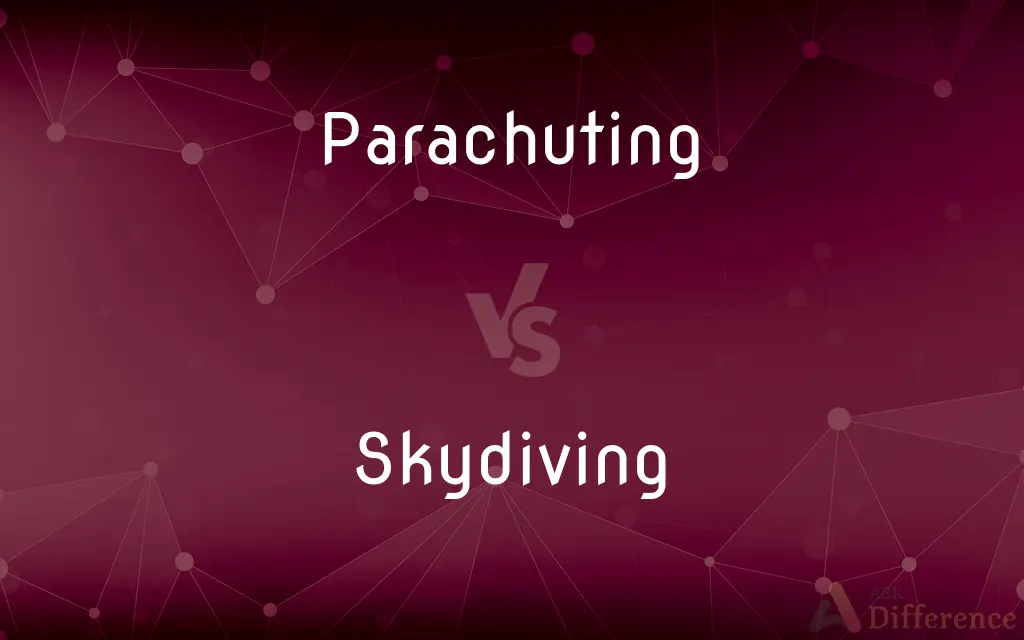Parachuting vs. Skydiving — What's the Difference?
By Fiza Rafique & Maham Liaqat — Updated on March 20, 2024
Parachuting is the act of jumping from an aircraft and descending with a parachute, focusing on the controlled use of the parachute, whereas skydiving involves free-falling from an aircraft before deploying a parachute, emphasizing the free-fall aspect.

Difference Between Parachuting and Skydiving
Table of Contents
ADVERTISEMENT
Key Differences
Parachuting primarily centers around the use of the parachute for descent after jumping from an aircraft. It encompasses a range of activities that rely on parachute technology, including static-line jumps where the parachute deploys automatically upon exit and precision landing competitions. Skydiving, on the other hand, places a significant emphasis on the free-fall phase prior to parachute deployment. It's not just about descending safely but also enjoying the sensation of free-falling and performing maneuvers in the air.
In parachuting, the jump may be executed from various altitudes, but the focus remains on the controlled descent and landing. Activities such as BASE jumping and military parachuting fall under this broader category. Skydiving, conversely, typically involves jumps from higher altitudes—often around 13,000 feet—allowing for a longer free-fall duration, during which skydivers experience the thrill of falling at high speeds before opening their parachutes.
Training and equipment for parachuting and skydiving also differ based on the activity's focus. Parachuting training might emphasize the deployment, control, and landing of the parachute, including how to handle various emergency scenarios. Skydiving training, while also covering these aspects, places additional emphasis on free-fall techniques, body control, and aerial maneuvers before the parachute is deployed.
The cultures surrounding parachuting and skydiving also reflect these differences. Parachuting can be seen as a broader category that includes various disciplines, some of which are utility-focused like rescue operations or military drops. Skydiving culture is more associated with the adventure sports community, emphasizing the exhilarating experience of free-fall, aerial acrobatics, and the social aspects of skydiving as a recreational activity.
While parachuting might include a range of purposes from practical to recreational, skydiving is almost always pursued for the thrill and sport of the free-fall experience. This distinction shapes how participants engage with each activity, from the training they undergo to the communities they form.
ADVERTISEMENT
Comparison Chart
Primary Focus
Controlled descent and parachute maneuvering
Free-fall experience followed by parachute deployment
Typical Activities
Static line jumps, precision landing, canopy formations
Formation skydiving, free-fall acrobatics, BASE jumping
Training Emphasis
Parachute deployment, navigation, and precision landing
Free-fall techniques, body control, safe deployment, and landing
Free-fall Component
Minimal to none, immediate or strategic parachute deployment
Significant, with free-fall preceding parachute deployment
Recreational Appeal
In the parachute flight and maneuvering
In the thrill of free-fall and aerial acrobatics
Compare with Definitions
Parachuting
The act of descending from a height using a parachute.
Parachuting from a plane involves careful control of the parachute.
Skydiving
A sport involving a free-fall from an aircraft before deploying a parachute.
Skydiving gives an adrenaline rush like no other.
Parachuting
May include activities like canopy formations.
The team performed a complex canopy formation while parachuting.
Skydiving
Focuses on the thrill and techniques of free-fall.
He loves performing acrobatics during the free-fall phase of skydiving.
Parachuting
Can be used for various purposes, including military and emergency.
Emergency parachuting is a critical skill for pilots.
Skydiving
Requires training in free-fall body control and safety.
Skydiving schools teach how to control your body during free-fall.
Parachuting
Involves training focused on parachute deployment and control.
She took a parachuting course to learn precision landing.
Skydiving
Often includes formation jumps and aerial stunts.
The skydiving team set a record for the largest free-fall formation.
Parachuting
Emphasizes control and technique in parachute use.
Parachuting competitions often judge precision in landing and control.
Skydiving
Popular as an extreme sport and recreational activity.
She went skydiving on vacation for an unforgettable experience.
Parachuting
Parachuting, including also skydiving, is a method of transiting from a high point in the atmosphere to the surface of Earth with the aid of gravity, involving the control of speed during the descent using a parachute or parachutes. For human skydiving, it may involve a phase of more or less free-falling (the skydiving segment) which is a period when the parachute has not yet been deployed and the body gradually accelerates to terminal velocity.
Skydiving
To jump and fall freely from an airplane, often performing various maneuvers, before deploying a parachute.
Parachuting
An apparatus used to retard free fall from an aircraft, consisting of a light, usually hemispherical canopy attached by cords to a harness and worn or stored folded until deployed in descent.
Skydiving
The practice of performing acrobatic movements during the freefall phase of a parachute jump.
Parachuting
Any of various similar unpowered devices that are used for retarding free-speeding or free-falling motion.
Skydiving
Present participle of skydive
Parachuting
To drop (supplies or troops, for example) by means of a parachute.
Skydiving
Performing acrobatics in free fall before pulling the ripcord of a parachute
Parachuting
To descend by means of a parachute.
Parachuting
The sport of jumping with a parachute.
Parachuting
Present participle of parachute
Parachuting
The act or process of descending from a high altitude to the ground by means of a parachute.
Parachuting
Descent with a parachute;
He had done a lot of parachuting in the army
Common Curiosities
What is the main difference between parachuting and skydiving?
Parachuting focuses on the descent and parachute control, while skydiving emphasizes the free-fall experience.
Can skydiving be considered a type of parachuting?
Yes, skydiving is often considered a subset of parachuting, specifically focusing on the free-fall aspect.
Is parachuting used for purposes other than recreation?
Yes, parachuting can be used for military, emergency, and other practical purposes.
Is there competitive parachuting?
Yes, there are competitive parachuting events that judge precision landing, canopy control, and other skills.
Can someone participate in parachuting without extensive free-fall?
Yes, certain types of parachuting jumps, like static line jumps, involve minimal to no free-fall.
Can you do acrobatics in parachuting?
While acrobatics are more common during the free-fall phase of skydiving, canopy piloting in parachuting can involve maneuvers.
Is training different for parachuting and skydiving?
Yes, training for parachuting may focus more on parachute control, while skydiving training emphasizes free-fall techniques.
Do you always free-fall in skydiving?
Yes, free-fall is a defining component of skydiving before the parachute is deployed.
Do all skydivers perform aerial stunts?
Not all skydivers perform stunts; some may simply enjoy the free-fall and the scenic descent.
How long does the free-fall in skydiving last?
The duration of the free-fall can vary, usually lasting between 30 seconds to a minute, depending on the jump altitude.
Are parachuting and skydiving safe?
Both activities involve risks, but with proper training, equipment, and adherence to safety protocols, they can be performed safely.
What equipment is essential for both parachuting and skydiving?
A well-maintained parachute, altimeter, helmet, and sometimes an automatic activation device (AAD) are essential.
What is BASE jumping?
BASE jumping involves parachuting or wingsuit flying from a fixed structure or cliff, and is considered an extension of skydiving.
What motivates people to try skydiving or parachuting?
Many are drawn to the thrill, the challenge, and the unique sense of freedom and accomplishment these activities offer.
What is formation skydiving?
Formation skydiving involves multiple skydivers creating shapes or formations during the free-fall phase before deploying their parachutes.
Share Your Discovery

Previous Comparison
Jealous vs. Possessive
Next Comparison
Guy vs. ManAuthor Spotlight
Written by
Fiza RafiqueFiza Rafique is a skilled content writer at AskDifference.com, where she meticulously refines and enhances written pieces. Drawing from her vast editorial expertise, Fiza ensures clarity, accuracy, and precision in every article. Passionate about language, she continually seeks to elevate the quality of content for readers worldwide.
Co-written by
Maham Liaqat













































